Discovering blood on your sheets can be alarming, but don’t panic! This guide provides a comprehensive, step-by-step approach to removing both fresh and dried blood stains, ensuring your bedding stays pristine. We’ll explore various techniques, from initial rinsing to pre-treatment options and laundering best practices, catering to different fabric types.
From Crimson to Clean: A Step-by-Step Stain Removal Strategy
1. Immediate Action: The Critical First Step
Time is your biggest enemy when it comes to blood stains. Fresh blood is significantly easier to remove before it binds to fabric fibers. Swift action, ideally within the first hour, dramatically increases your chances of complete stain removal. Delayed treatment allows the stain to set, making it significantly more challenging to eliminate.
2. The Cold Water Rinse: Your Primary Weapon
Your first line of defense is cold running water. Never use hot water on a fresh blood stain. Hot water cooks the blood proteins, permanently setting the stain. Cold water, conversely, helps flush out the blood before it has a chance to set. This simple step can often remove fresh stains entirely.
3. Pre-Treatment: Customized Stain Removal
The pre-treatment stage requires tailoring your approach based on the stain’s age and your sheet’s fabric type.
Fresh Blood Stains:
- Hydrogen Peroxide (Light-Colored Sheets Only): A small amount of 3% hydrogen peroxide, dabbed onto the stain, works as a mild bleach, breaking down the blood’s components. The fizzing action indicates it’s working. Always test on a hidden area first, as hydrogen peroxide can bleach colored fabrics.
- White Vinegar (Dark-Colored Sheets): White vinegar, a natural cleaning agent, effectively lifts fresh blood stains from dark-colored sheets without the risk of bleaching. Apply directly to the stain and allow it to work for several minutes before rinsing.
- Enzyme Cleaner (All Colors): Enzyme cleaners are specifically formulated to break down organic matter, making them highly effective on blood. Follow the product instructions precisely for optimal results and fabric safety. They are a safe and effective choice for all sheet colors.
Dried Blood Stains:
- Extended Enzyme Soak (All Colors): For dried blood, an extended soak is key. Submerge the stained area in cold water with an enzyme cleaner for a minimum of one hour, and consider an overnight soak for particularly stubborn stains. This gives the enzymes ample time to break down the dried blood proteins. For maximum effectiveness, periodically refresh the soaking solution.
- Meat Tenderizer Paste (Sturdy Fabrics Only): This unconventional method utilizes the enzymes in unseasoned meat tenderizer to break down blood proteins. Create a paste with cold water and apply it to the stain for 30-60 minutes before rinsing thoroughly. Caution: Meat tenderizer can damage delicate fabrics. Always test on an inconspicuous area first. Avoid using this method on silk, satin, or lace.
- Baking Soda Paste (All Colors): Create a paste using baking soda and a small amount of water. Apply generously to the dried blood stain and allow it to dry completely, preferably in sunlight. The baking soda helps to lift and absorb the remaining blood. Gently brush off the dried paste and rinse the area with cold water.
4. Laundering: The Final Step for Pristine Sheets
After pre-treating, launder your sheets as usual, but always use cold water. Remember, hot water sets any remaining stain, potentially making it permanent. Before transferring to the dryer, inspect the stained area carefully. If any trace of the stain remains, repeat the pre-treatment and laundering process. Air drying is the safest option, especially for delicate fabrics or if you suspect the stain persists. Dryer heat can permanently set any remaining blood.
Fabric-Specific Care: Protecting Your Investment
- Delicate Fabrics (Silk, Satin, Lace): Exercise extreme caution with delicate materials. Always dilute cleaning solutions and test in an inconspicuous area first. For stubborn stains or valuable items, professional dry cleaning is recommended. Professional cleaners possess specialized expertise in handling delicate fabrics and stubborn stains.
- Sturdy Fabrics (Cotton, Linen): These durable fabrics can tolerate more robust cleaning methods. However, prioritize cold water and test any unfamiliar cleaning solution on a hidden area to prevent discoloration or damage.
Troubleshooting: Addressing Persistent Stains
- Reappearing Stains: If a stain reappears after washing and drying, repeat the pre-treatment and laundering process. Deeply embedded stains may require multiple treatments for complete removal.
- Halo Effect: A lighter ring or halo around the treated area indicates uneven solution application or insufficient rinsing. Ensure thorough, even saturation of the stain during pre-treatment and rinse the area completely before laundering to prevent this issue.
By diligently following these steps and adapting them to your specific situation, you can effectively banish blood stains, preserving the freshness and cleanliness of your bedding.
- Witcher 3 Modlist Essential Picks For Your Next-Gen Game - December 17, 2025
- Witcher Nexus: Discover The Best Witcher 3 Mods - December 16, 2025
- Witcher 3 Next Gen Mods Bring New Quests and Visual Enhancements - December 15, 2025










